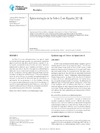Please use this identifier to cite or link to this item:
https://accedacris.ulpgc.es/jspui/handle/10553/54931
| Title: | Epidemiología de la fiebre Q en España (2018) | Other Titles: | Epidemiology of q fever in Spain (2018) | Authors: | Pérez-Arellano, José L. Carranza Rodríguez, Cristina Gutierrez, Carlos Bolaños-Rivero, Margarita |
UNESCO Clasification: | 320505 Enfermedades infecciosas | Keywords: | Fiebre Q Coxiella burnetii Epidemiología España Epidemiology |
Issue Date: | 2018 | Publisher: | 0214-3429 | Journal: | Revista Espanola de Quimioterapia | Abstract: | La fiebre Q es una antropozoonosis cuyo agente causal
es Coxiella burnetii que presenta una repercusión importante
desde el punto de vista de la salud humana y animal. En esta revision, inicialmente se ha realizado una breve referencia
histórica de la infección por C. burnetii y la fiebre Q. En un
segundo apartado se describen los aspectos epidemiológicos
básicos de esta infección (reservorios/fuentes de infección, forma de transmisión y formas epidemiológicas). Posteriormente
se indican los datos de la infección por C. burnetii en España,
tanto las series clínicas, los estudios seroepidemiológicos en
humanos, la afectación de diferentes tipos de mamíferos y la
participación de las garrapatas en el ciclo biológico. Además,
se incluyen los datos básicos de la infección/enfermedad por C.
burnetii en otras regiones del mudo. Finalmente, y teniendo en
cuenta los datos previos se indican las principales características epidemiológicas de la fiebre Q en la actualidad. Q fever is an anthropozoonosis whose causative agent is Coxiella burnetii, which has an important impact from the human and animal health point of view. In this review, a brief historical reference of the infection by C. burnetii and Q fever has been made initially. In a second section the basic epidemiological aspects of this infection are described (reservoirs/ sources of infection, form of transmission and epidemiological forms). Subsequently, the data of the infection by C. burnetii in Spain will be are indicated, particularly the clinical series, the seroepidemiological studies in humans, the affectation of different types of mammals and the participation of the ticks in the biological cycle. In addition, basic data on C. burnetii infection/ disease in other regions of the world will be are also included. Finally, and taking into account the previous data will indicate the main epidemiological characteristics of Q fever at present. |
URI: | https://accedacris.ulpgc.es/handle/10553/54931 | ISSN: | 0214-3429 | Source: | Revista Española de Quimioterapia [ISSN 0214-3429], v. 31 (5), p. 386-405 |
| Appears in Collections: | Reseña |
SCOPUSTM
Citations
10
checked on Jun 8, 2025
WEB OF SCIENCETM
Citations
6
checked on Feb 25, 2024
Page view(s)
176
checked on Oct 26, 2024
Download(s)
98
checked on Oct 26, 2024
Google ScholarTM
Check
Share
Export metadata
Items in accedaCRIS are protected by copyright, with all rights reserved, unless otherwise indicated.
